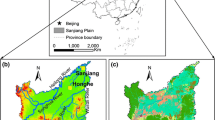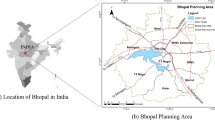Abstract
Wetland loss has been the major environmental problem in Sanjiang Plain, NE China in recent years because of the dramatic agricultural development. We determined the spatial associations of the wetland loss rates in an 11,000-km2 study area for two intervals of period 1 (1975–1989) and period 2 (1989–2004) spanning 30 years by using geographic information systems. The landscape of this area was simple with five categories, composed of ten types, and including three natural wetland types—open water, marsh, and wet meadow. Extensive agriculture was the principal cultivation form in terms of large size farm units in the area. Agriculture has become the principal land use category replacing natural wetlands over the 30-year period. It has changed the whole landscape of the region and the landscape pattern, causing wetland loss and fragmentation. The wetland loss rate of the area was very different between the two intervals, while wetland loss was not uniform throughout the region and was influenced by the landscape characteristics, such as topography, geomorphology, and the location of the wetlands in the watershed. Despite the remarkable land use changes, the wetlands distribution in the landscapes was similar compared to their original pattern. These results indicated that agricultural development affected the areas more than the distribution pattern of the wetlands in this region.
Similar content being viewed by others
References
Balmford, A., Bruner, A., Copper, P., Costanza, R., Farber, S., Green, R. E., et al. (2002). Economic reasons for conserving wild nature. Science, 297, 950–953. doi:10.1126/science.1073947.
Bedford, B. L., & Preston, E. M. (1988). Developing the scientific basis for assessing cumulative effects of wetland loss and degradation on landscape functions: status, perspectives, and prospects. Environmental Management, 12(5), 751–771. doi:10.1007/BF01867550.
DeBusk, W. F. (1999). Functional role of wetlands in watersheds. A fact sheet of the Soil and Water Science Department, Florida Cooperative Extension Service, Institute of Food and Agricultural Sciences, University of Florida. Published on July 1999. Retrieved from http://edis.ifas.ufl.edu.
Elkie, P., Rempel, R., & Carr, A. (1999). Patch analyst user’s manual, TM-002 (p. 16). Thunder Bay, ON: Ontario Ministry of Natural Resource, Northwest Science and Technology.
Forman, R. T. T. (1995). Some general principles of landscape and regional ecology. Landscape Ecology, 10, 133–142. doi:10.1007/BF00133027.
Gibbs, J. P. (2000). Wetland loss and biodiversity conservation. Conservation Biology, 14(1), 314–317. doi:10.1046/j.1523-1739.2000.98608.x.
Gopal, B., & Junk, W. J. (2001). Assessment, determinant, function and conservation of biodiversity in wetlands: Present status and future need. In B. Gopal, W. J. Junk, & J. A. Davis (Eds.), Biodiversity in wetlands: Assessment, function and conservation (pp. 277–302). Leiden: Backhuys.
Kennish, M. J., Belton, T. J., Hauge, P., Lockwood, K., & Ruppel, B. (1992). Polychlorinated biphenyls in estuarine and coastal marine waters of New Jersey: A review of existing pollution problems. Reviews in Aquatic Sciences, 6, 275–293.
Kershner, J. L. (1997). Setting riparian/aquatic restoration objectives within a watershed context. Restoration Ecology, 5, 15–24. doi:10.1111/j.1526-100X.1997.00015.x.
Liu, H., Zhang, S., Li, Z., Lu, X., & Yang, Q. (2004). Impacts on wetlands of large-scale land use changes by agricultural development: The Small Sanjiang Plain, China. Ambio, 6, 306–310.
Matthews, J. W., Paul, A. B., Tessene, A., Wiesbrook, S. M., & Zercher, B. W. (2005). Effect of area and isolation on species richness and indices of floristic quality in Illinois, USA wetlands. Wetlands, 3, 607–615. doi:10.1672/0277-5212(2005)025[0607:EOAAIO]2.0.CO;2.
Mensing, D. M., Galatowitsch, S. M., & Tester, J. R. (1998). Anthropogenic effects on the biodiversity of riparian wetlands of a northern temperate landscape. Journal of Environmental Management, 53, 349–377. doi:10.1006/jema.1998.0215.
Mitsch, W. J., & Gosselink, J. G. (1993). Wetlands (pp 7–22). New York: Van Nostrand Reinhold.
OECD/IUCN (1996). Guidelines for aid agencies for improved conservation and sustainable use of tropical and sub-tropical wetlands. Paris: OECD.
Semlitsch, R. D., & Bodie, J. R. (1998). Are small, isolated wetlands expendable? Conservation Biology, 12(5), 1129–1133. doi:10.1046/j.1523-1739.1998.98166.x.
Spaling, H. (1995). Analyzing cumulative environmental effects of agricultural land drainage in southern Ontario, Canada. Agriculture Ecosystems & Environment, 53, 279–292. doi:10.1016/0167-8809(94)00567-X.
State Forestry Administration China (2004). Report of the first survey of national wetland resources (in Chinese).
Turner, M. G., & Gardner, R. H. (1991). Quantitative methods in landscape ecology. New York, USA: Springer.
Turner, M. G., Gardner, R. H., & O’Neill, R. (2001). Landscape ecology in theory and practice: Pattern and process. New York: Springer.
Walters, D., & Shrubsole, D. (2003). Agricultural drainage and wetland management in Ontario. Journal of Environmental Management, 69(4), 369–379. doi:10.1016/j.jenvman.2003.09.013.
Wang, X., & Wu, Y. (2004). Degeneration and ecological rehabilitation of wetlands in Jianghan Plain, China. Journal of Huazhong Agricultural University, 23(4), 467–471 (in Chinese).
Wang, Z., Zhang, B., Zhang, S., Li, X., Liu, D., Song, K., et al. (2006). Changes of land use and of ecosystem service values in Sanjiang Plain, Northeast China. Environmental Monitoring and Assessment, 112, 69–91. doi:10.1007/s10661-006-0312-5.
Xiao, D., & Li, X. (2001). Landscape dynamics and sustainable land use of coastal wetlands resources in Liaohe Delta, China. Resources Science, 23(2), 31–36 (in Chinese).
Yi, G., Risley, D., Koneff, M., & Davis, C. (1994). Development of Ohio’s GIS-based wetlands inventory. Journal of Soil and Water Conservation, 49(1), 23–28.
Author information
Authors and Affiliations
Corresponding author
Rights and permissions
About this article
Cite this article
Zhang, J., Ma, K. & Fu, B. Wetland loss under the impact of agricultural development in the Sanjiang Plain, NE China. Environ Monit Assess 166, 139–148 (2010). https://doi.org/10.1007/s10661-009-0990-x
Received:
Accepted:
Published:
Issue Date:
DOI: https://doi.org/10.1007/s10661-009-0990-x




